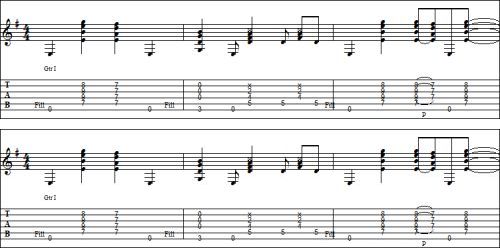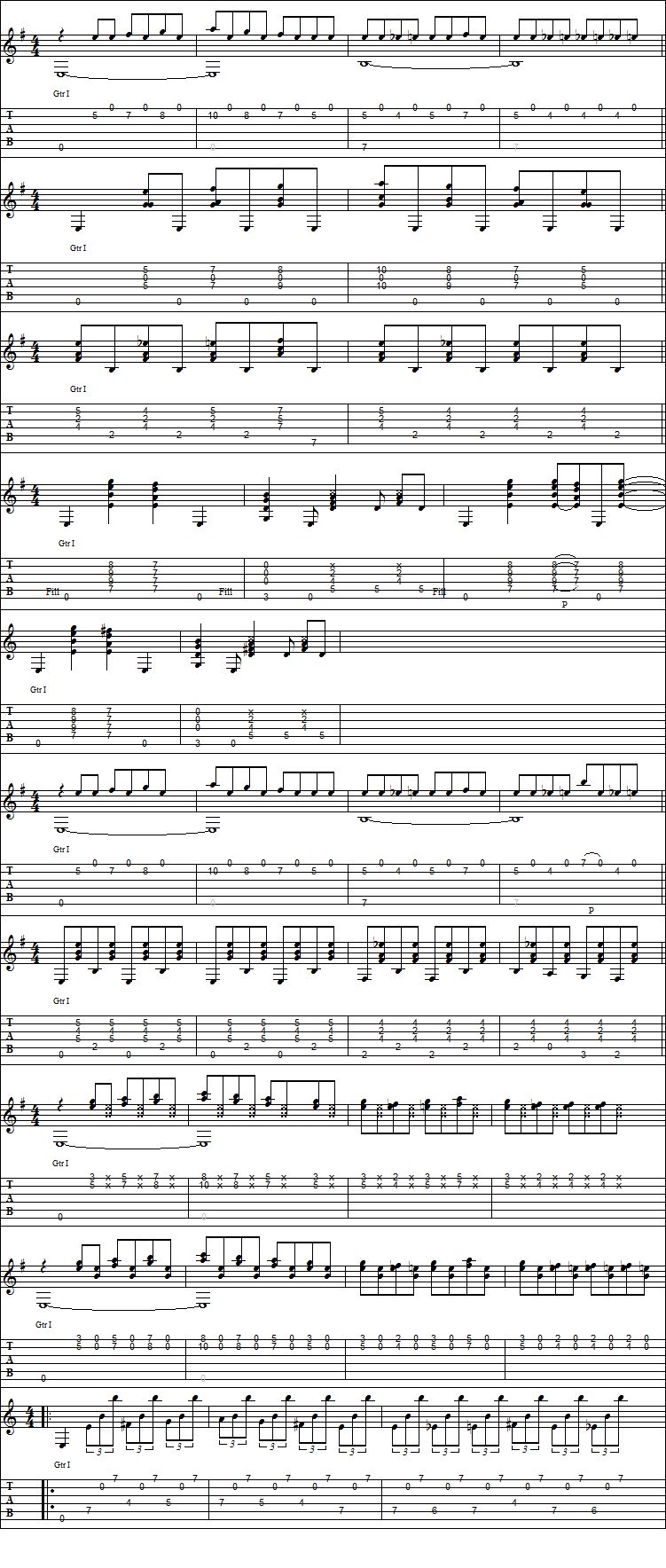How often have you heard a really cool arrangement of a cover song and thought "wow, where did they come up with that?" I've been there many times myself and while I can't tell what goes on in others minds when they are arranging a piece, I can offer some insight into my rendition of The Rolling Stones classic, "Paint It Black".
The first step is often to pick a key. I usually try to keep a song in the original key but often when you are trying to do various chord voicings, a bass line, and the melody, the key may have to be changed to even make that all possible. I chose Em so that I could maintain an open "E" bass line where needed. Just a quick note, this is often where alternate tunings may come into play. As you will see though, for the V chord, the "B" (which I chose to play as a B7 as I felt it added to the "Gypsy" style I was trying to achieve) that presented a problem for one voicing.
On the intro (fig. 1) I felt it was needed to begin with a bass note ringing then proceed with the main melody. Notice for the "B" chord I put the bass note on the 6th string as well. This just felt more comfortable due to some of the classical pieces I played in my teens. I decided to leave out the little trill on the intro and opt for the more trance like repeating of last few notes for dynamic reasons. For myself, I just thought it added more tension for what was about to come. The drum hits I did on the body of the guitar but only did 4 rather 8 as in the original. I did this to not become redundant with it since this was solo acoustic guitar and not a rock band.

For the verse, which is basically the main intro melody, I wanted something more full than on the intro so a droning string was a good option but I didn't want the melody to get drowned out. I decided to put a harmony on the low end, a 6th below. This worked well as a 6th below is the same as a 3rd above but down an octave. Thirds are typically the most commonly used harmony (and I make use of that later too) but I felt if the harmony were higher it would detract from the melody. At the same time I am keeping the "G" string going throughout the Em chord (see fig. 2). Notice again, I started with a bass note as the pickup note just give it some depth.

The second half of the verse is a bit more challenging. It starts off as basically a B7sus4 (see fig. 3) then the melody changes it to a B7 then back to the B7sus4. The tricky part was getting the F# which came next in the melody. It would have been much closer to put the F# on the high E string however, this would have disrupted the flow of the right hand picking. On the right hand I am using the thumb for the bass note each time and using I, M, & A (index, second, & third fingers) to pluck the remaining adjacent strings. Putting the F# on the high E would have meant separating the picking fingers which may work for well for some of you but I opted to keep that flow going. So, this meant moving the chord up the neck. Notice also, in fig. 3 when I do move the B7 chord up the neck for that one hit, I ad a "C" in the middle of the chord. I thought of keeping the "B" on the 3rd string at the 4th fret to maintain the B7 chord but I personally liked the "C" in there to ad more of a diminished feel to the chord. I thought it gave it more tension and was easier to hit. Nothing wrong with a win-win situation right?

The main trick with a solo arrangement is to try to keep repeated parts (verses, choruses etc.) interesting. Since the verses on "Paint It Black" were pretty short and I felt had a good drive to them, I wasn't so concerned with variety there and decided to alter the choruses. This is kind of the opposite approach to most vocal songs if you think about it? I also decided to keep the first part of the chorus the same each time but to make each fill more interesting than the previous, a good technique to employ in any arrangement (see fig. 4).

When the song breaks and goes back to the main melody as played on the intro I chose to slow the part down as to accentuate the break more. An interesting note (pun intended), and this might help demonstrate how any arrangement can still evolve, is the high B pulled off to the open high E string on this section (fig.5). I had honestly played this song for about a year and a half then one day while I was teaching a guitar lesson, I was showing the student a little bit about arranging and chord voicings and boom, there was this high B on the first string that had been there this entire time yet I never saw it. My hand position even had my pinky right over the note but I never noticed it there? This has a bit more to do with how our mind works (or doesn't sometimes) but I'm sure most of you have experienced the same thing. Playing a song over and over then one day, you notice something that was there but you never saw before. This idea, combined with the fact that we grow, evolve, and advance as players, enables what may seem like a set arrangement to continue and grow also. Another example of this appears later.

You will probably notice that the tempo I play the majority of the song is a bit faster than the original. I admit, I was a little guilty of the "live adrenaline rush syndrome" which formula reads: musician + live show = increased tempo, but a good part of this was intentional too (yeah right...no, seriously). I really wanted to exaggerate the "gypsy" feel that I always felt the song possessed. This becomes even more evident in - drum roll (or should I say, guitar lick) - the guitar solo.
I didn't transcribe the guitar solo for this article but a good set of ears will pick up on several arpeggios and extensive use of the E Harmonic Minor scale. For the rhythm part, I basically used my twist on the progression of the song: Em - B7 only with more of a gypsy-jazz vamp to it (fig. 6). Notice the bass line alternates between the root and the fifth (E to B over the Em & opposite - F# to B over the B7). A side note to fingering, on the descending bass line over the B7 chord, the index finger will have to adjust to barre the B, then open the fifth string for the A. A suggestion here is not to simply lift the index finger as this usually results in a muffled 7th (the A on the third string). I prefer to slide the index finger down towards the third string and use my second finger when the G in the bass comes, then the index finger again for the F# in the bass.

After the guitar solo I brought the melody back in as to not get too far removed from the song. This time is done with a harmony a third above played at the same time (a.k.a. double stops). Originally, I muffle the E & B strings in between the double stops (fig. 7). Earlier I mentioned how arrangements can evolve and change. The way I now perform this section (another part I did not see until later, as in, after my live CD, "It's Alive One" was recorded and released) by pivoting to the open E & B strings after each of the double stops are hit. In the recorded version I muffle the E & B string in between whereas now, I play those strings open after each broken chord (fig. 8). This works, as the E & B are both in the Em chord and gives you a Sus 4 with the B chord, which is perfect for resolving back to the Em chord. On the last two repetitions of this progression, I strum an open Em chord rather than just hit the open low E. Again; this is to make the arrangement build a little.


Once again, arrangements evolve. For about a year or two I ended the song there. Then one day I was experimenting with putting the melody in the bass end much like as in "Leyenda" and "Maleguena". Voila! There it was, a bit tricky to play due to the stretching buts adds a certain "fire" to make the piece climax (fig 9). This part always gets the best part of the audience response. I put little diminished fills in between the droning B/D# chord just to make it less redundant.


There you have it folks, a little insight into at least the way that I came up with this gypsy-esque arrangement of the classic, "Paint It Black". Keep in mind this was simply the way I approached it and everyone thinks differently which is why there are so many arrangements of many of the same songs. Not to mention that, on different days, our minds work differently and may or may not see things that may later or to others seem obvious. Also, keep in mind, as I hope I illustrated here that no arrangement is set in stone and don't be afraid to let it grow and evolve as you do as a player. The bottom line, your mileage may vary. Best of luck.
On his solo debut release, "El Samuraichi", guitarist Chris Dunnett combined a wide range of styles such as traditional Flamenco, Latin, Middle Eastern, Gypsy, and Neo-classical music.
His most recent CD, "Higher Glyphics" takes that blend a step further by adding Reggae, Calypso, choirs and Arabian voices to the mix.